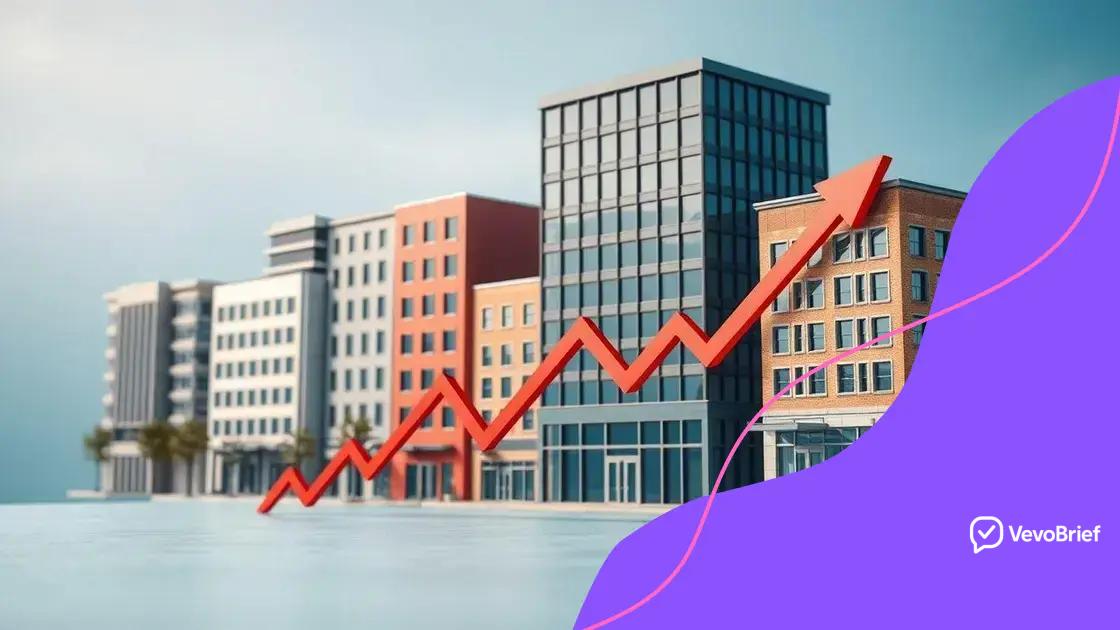Rising rates impact commercial real estate market trends

Rising rates impact commercial real estate by increasing borrowing costs, reducing buyer demand, and driving down property values, making it crucial for investors to adapt their strategies accordingly.
Rising rates impact commercial real estate significantly, altering how investors and companies approach the market. Have you thought about how these changes affect your investments? Let’s dive into what this means for you.
Understanding the current interest rate environment
Understanding the current interest rate environment is crucial for real estate investors. It helps to make informed decisions and navigate the complexities of commercial real estate today.
The recent trends show a rising interest rate, which is impacting various sectors. By staying updated, you can better prepare for changes in the market.
Key Factors Influencing Interest Rates
Several elements determine interest rate changes, including:
- Inflation rates and economic growth
- Federal Reserve policies and decisions
- Global economic conditions
The actions taken by the Federal Reserve heavily influence the interest rates. When the economy is booming, rates tend to rise, leading to increased borrowing costs. Conversely, during economic slowdowns, rates may drop to encourage spending.
Impact on Commercial Real Estate
Rising rates can have varied effects on the commercial real estate market. Higher borrowing costs often lead to:
- A decrease in new property developments
- A slowdown in the purchasing of existing properties
- Increased scrutiny on property valuations
Investors must adapt to this changing environment. Strategies may include focusing on properties with stable cash flows or leveraging equity financing rather than debt. Understanding how to react to these shifts can be pivotal.
Staying informed about the current interest rate environment helps investors make strategic decisions, ensuring they remain competitive in a fluctuating market. Continually analyzing trends ensures that you can capitalize on opportunities as they arise.
Effects of rising rates on property values
The effects of rising rates on property values can be significant. Investors need to grasp how these changes can impact their assets and the overall market.
When interest rates rise, financing costs for property purchases increase. This can lead to fewer buyers in the market, which often results in a drop in property values. It’s essential to be aware of these dynamics when considering investments.
Market Dynamics
Higher interest rates typically lead to:
- A decrease in buyer demand
- A slowdown in new construction projects
- Increased pressure on existing property values
As buyer demand declines, sellers may have to lower prices to attract prospective buyers. This can create a ripple effect, where properties in a certain area see decreasing values due to the overall market adjustment.
Long-term Implications
Rising interest rates may also affect how properties are appraised. Appraisers consider the cost of financing when determining a property’s worth. If rates are elevated, the value that potential buyers are willing to pay could be lower.
Moreover, the effect on rental properties could be notable as well. With rising rates, tenants might seek less expensive options, which could impact rental prices and property income stability. Investors may need to adapt their strategies accordingly to maintain profitability.
Ultimately, understanding the effects of rising rates on property values is crucial for making informed decisions in real estate investment. Keeping a pulse on these trends helps investors plan their next steps and mitigate potential risks.
Investment strategies in a high-rate scenario

Investment strategies in a high-rate scenario require careful planning and smart decisions. With rising interest rates, investors must adapt to new market conditions to maintain profitability in commercial real estate.
Many traditional financing methods may become less appealing, so it’s essential to explore alternative approaches. Understanding how to react to a high-rate environment can set successful investors apart.
Diversifying Investment Portfolios
One effective strategy is diversifying your investment portfolio. This can help reduce risk and improve returns. Here are some ways to diversify:
- Invest in different property types such as office, retail, and industrial.
- Explore different geographic markets to tap into emerging opportunities.
- Consider industrial properties, which often perform well in various economic conditions.
Diversifying helps shield your investments from sudden market changes, especially during high-rate periods.
Focusing on Cash Flow
Another crucial strategy is to focus on properties that provide strong cash flow. High-interest rates can reduce buyer interest, leading to lower property values. Thus, identifying properties that consistently generate income becomes vital.
Some factors to consider for cash flow properties include:
- Long-term leases with reliable tenants.
- Strong local demand for rental spaces.
- Low vacancy rates in the area.
With reliable cash flow, investors can better weather the storms of rising interest rates.
Finally, staying informed about market trends and economic indicators is key. Regularly review interest rate forecasts and economic reports. Adjusting your strategy based on the latest data can help safeguard your investments. It’s essential to remain proactive and flexible in your approach, especially in a fluctuating economy.
Long-term consequences for commercial leasing
The long-term consequences for commercial leasing in a rising interest rate environment can be significant. Understanding these impacts is vital for property owners and investors.
As interest rates rise, leasing costs can also increase. This change may lead to higher rents, affecting both tenants and landlords. Keeping a close eye on leasing trends is crucial for planning future investments.
Impact on Lease Agreements
Higher interest rates affect the structure of lease agreements. Landlords may opt for longer lease terms to lock in rents. This can lead to:
- Less turnover in commercial properties
- Increased investment in property maintenance
- More stable rental income for landlords
However, longer leases can also limit flexibility for both parties. Tenants may find it harder to adapt to changing market conditions, while landlords may miss out on higher rents if the market improves.
Tenant Considerations
For tenants, rising interest rates can mean tighter budgets. Businesses may reconsider their space needs or negotiate harder for better terms. It’s essential for tenants to evaluate:
- The total cost of occupancy
- Potential for concessions from landlords
- Location and value of the space
As a result, some businesses may seek alternatives such as shared office spaces or co-working environments, aiming for flexibility as market dynamics shift.
Landlords and property managers should be proactive in addressing these challenges. Offering adaptable lease terms or incentives can attract and retain tenants in a competitive environment.
Moreover, understanding the long-term implications of rising rates is crucial for tailoring leasing strategies. Monitoring market trends and being flexible with lease agreements can greatly benefit all parties involved in commercial leasing.
Market predictions: navigating future challenges
Market predictions are essential for navigating future challenges in the commercial real estate sector. Understanding potential shifts can help investors and property owners make informed decisions.
As interest rates continue to rise, experts forecast various outcomes for the market. Keeping these predictions in mind is important for adapting strategies.
Trends to Watch
Several key trends are emerging that will shape the future of commercial real estate:
- Increased demand for flexible spaces: Companies are shifting towards remote work and need adaptable workspaces.
- Focus on sustainability: Properties that meet green certifications may see higher values and demand.
- Growth in e-commerce: Industrial spaces for logistics and warehousing may remain in high demand as online shopping increases.
Monitoring these trends provides valuable insights into where the market is heading. Investors should be prepared to adjust their portfolios accordingly to maximize returns.
Anticipating Changing Investor Behavior
As market conditions evolve, investor behavior may also change. Investors might seek:
- Opportunities in emerging markets or undervalued assets.
- Properties with strong cash flow as a buffer against economic volatility.
- Partnerships or joint ventures to mitigate risks.
By being aware of these potential shifts, stakeholders can position themselves more effectively in a competitive environment. Flexibility and preparedness are essential to success.
The future may bring challenges, but with informed strategies and a keen understanding of market predictions, navigating these changes becomes more manageable. A proactive mindset will empower investors to adapt and thrive amidst the uncertainties of the commercial real estate landscape.
FAQ – Frequently Asked Questions about Commercial Real Estate and Rising Interest Rates
How do rising interest rates affect property values?
Rising interest rates generally lead to increased borrowing costs, which can decrease buyer demand and result in lower property values.
What strategies can I use in a high-rate environment?
Strategies include diversifying your investment portfolio, focusing on properties with strong cash flow, and being flexible with leasing agreements.
How can landlords adapt to changing market conditions?
Landlords can offer adaptable lease terms, enhance property features, and actively engage with tenants to maintain occupancy.
What market trends should I watch for future investments?
Key trends include the demand for flexible spaces, sustainability in properties, and the growth of e-commerce affecting industrial spaces.
